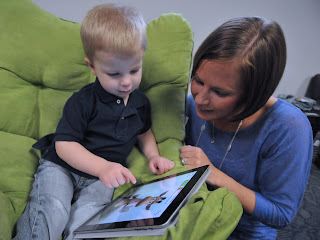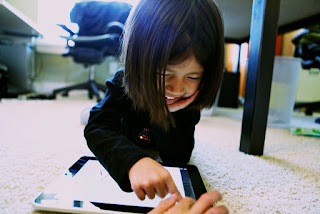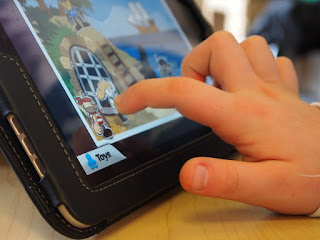Mobile Applications And Tools Have Been Developed To Augment Learning For Kids Education
General Words:
Children have always loved
running around, whether chasing one another through a shopping mall, darting
along a beach, or playing hide and seek in the woods. Nowadays, with a
selection of mobile technologies stuffed in their pockets or around their
necks, they can do more than simply enjoy the moment. With a digital camera or
an iPod at the ready, they can take pictures or record sounds they encounter
during their outdoor pursuits. They can tag these artistic creations with
comments and other personal details and then upload them to Facebook or another
social Website to share them with their friends, teachers, or family.
Description:
Another creative development is a
digital necklace that children can wear as part of a simulation game in which
they each pretend to be a virus. As the children move around a physical space,
they try to avoid or come into contact with each other, mimicking the way
viruses spread a common cold. The sensors on their necklaces do the spreading,
the outcome of which is depicted on a computer display. The contacts made by
the viruses appear as a brightly colored pattern that children can analyze and
through which they can trace their own spreading trajectories. These are just a
few examples of ways in which the new generation of mobile technologies is
changing the way children learn.
Not only is mobile learning
highly engaging, it also provides children with novel ways of relating their
physical experiences to abstract knowledge, from running around a playground to
understanding what a carbon footprint is. These innovative forms of physical
digital switching are thought to lead to a more in-depth understanding of a
topic. They also increase children’s opportunities to make connections between
their observations and ideas that can help them grasp difficult concepts. But
how do mobile learning applications compare with PC-based, educational software
programs that are now commonly used in schools to teach subjects such as math,
language arts, or science?
An important difference is the
way fixed and mobile computers are used. PCs are deskbound and ideally suited
to individual or pairs of children sitting in front of a computer screen,
focusing their attention on solving a problem or completing a set task during a
lesson. Mobile technologies are handheld and ideally suited for relatively
short bursts of use (such as entering and comparing data or looking up and
reviewing information) while involved in fore grounded physical activities,
such as exploring a forest. In other words, PCs support sedentary children
working primarily on digital tasks in the classroom or home, whereas mobile
technologies support embodied children engaged in a diversity of physical
activities and contexts.
An advantage of learning while
mobile is that children often become more motivated and engaged than when
staring at a PC while sitting still. But more significantly, mobile learning
opens up many new opportunities for ways in which children can learn. What
appear to be disparate activities can now be integrated over time and space. By
making more connections between their emergent ideas, prior knowledge, and
ongoing observations of the world, children are starting to view and understand
the world differently. This development in educational technology represents a
major shift in the way computers can be used to stretch children’s minds.
A number of mobile applications
and tools have been developed to augment learning. We describe these here in
terms of four types:
■ Physical exercise games
■ Participatory simulations
■ Field trips and visits
■ Content creation
Physical exercise games Mobile
technologies have been incorporated into a number of physical activities to
encourage children’s understanding of abstract phenomena. For example, Floor Math
combines a sensor-embedded floor mat with a visual representation of the number
system that appears on an adjacent screen (Scarlatos et al., 1999). When
children walk up and down the squares, the corresponding numbers change on the
screen. Walking the numbers is thought to make the activity more meaningful,
helping children to see and understand abstract concepts in a new way
(Scarlatos, 2006, p. 295). Similarly, Smart Step, developed by the same
researchers, requires children to play hopscotch, skip, and count at the same
time when practicing basic math skills.
This combination of physical and
mental activities is meant to hone motor skills, pattern recognition, rhythm,
and coordination. Physical exercise has also been coupled with other kinds of
informal learning. Spikol and Milrad (2009), for example, developed a game
called Skattjakt (Treasure Hunt in Swedish) that encourages teams of teenage
children to simultaneously run around a physical environment, in this case a
castle located on the university campus, to solve a mystery using mobile
devices. The game design was inspired by orienteering, a traditional
Scandinavian running sport involving navigation. Instead of mapping the
physical exercise directly to the learning of abstract concepts, it is loosely
coupled to orienteering skills, such as reading maps, and learning about
history and team collaboration. Cell phones present text and audio-based clues
at particular times, showing where the teams are on an interactive map of the
whole area.
Teenage girls playing the game
readily understood the connection between the physical exercise demanded of
them and the practice of orienting
skills. For example, one girl commented: “There is a different feeling running
when you have an added reason to do it.” Nintendo Wii applications are also
beginning to be used for learning various physical and cognitive skills. Kahol
and Smith (2008) found that playing Marble Mania improved the dexterity skills
that are needed for performing surgery; Vannoni and Straulino (2007) showed
that children were able to learn about force, velocity, and acceleration
through using a Wii remote to measure acceleration of a swinging pendulum. All
these applications use mobile technologies to bootstrap physical activities
(e.g., walking, running) with learning math, physics, or other cognitive skills
(e.g., orienteering).
At the same time, if the physical exercise is
designed to be strenuous, children’s health can equally benefit through the
children having to run, walk, or cycle while learning. Participatory
simulations A participatory simulation is a game in which sensor-based devices
are worn or carried by children to enact a complex phenomenon, such as
epidemiology. Each child plays the role of an element (e.g., a virus) at ground
level that they then view at bird’s-eye
level to see how their individual contribution
affects the whole system (Colella, 2000). Participatory simulations have
been developed to represent a number of systems and have been played out in
various settings, including classrooms, museums, and playgrounds.
They include:
(1) dynamic systems, such as a flu epidemic;
(2) embedded naturally occurring
phenomena, such as an earthquake; and
(3) imaginary worlds, such as a
magical place.
Dynamic systems Thinking Tags was
one of the earliest prototype systems that used homemade wearable computers to
simulate the spread of an epidemic (Colella, 2000). Participants wore the
mobile computing devices around their necks. Light- emitting diodes (LEDs) lit
up on them to indicate how many people each participant had been in contact
with. By pretending to be a virus, each child discovered how dynamic events
changed as a consequence of his or her behavior and on this basis made
real-time decisions about what to do next—for example, discover more, control,
prevent, or manage the events. More recently, a genetics simulation was
developed using the Thinking Tags technology to explore concepts related to
genetic inheritance, such as genotype and phenotype (MacKinnon et al., 2002).
Each tag was programmed with a
specific genotype that was not initially known to the students. The students
were simply told that their eye color (phenotype) was either green (dominant)
or red (recessive). Their task was to meet with other tagged children and
determine whether the eye color of their “virtual offspring” would be green or
red by observing the pattern of red and green LEDs that lit up on meeting.
Studies of students using the mobile tags showed that the technology pushed
them to become involved in the simulation, resulting in much discussion.
Thinking Tags have also been used
with very young children to help them learn about dental hygiene. According to
many dentists, children find it difficult to understand how eating candy and
drinking sugary drinks can cause their teeth to rot. Tooth decay caused by the
buildup of sugar is a difficult concept for young children to learn. Instead of
being taught about dental health the traditional way, five-year-old children
used Thinking Tags to experience improving or decaying dental health (Andrews
et al., 2003).
Conclusion:
In this context, the digital tags
were used to simulate the decay process, enabling the children to experience it
firsthand and then talk about it. The technology provided a much more
accessible way of learning about a difficult topic. More recently, cheaper and
more robust personal digital assistants (PDAs) have been used to replace the
fragile and expensive tags, with similar learning benefits (Klopfer et al.,
2002). The PDAs have other advantages in that children can access further
information at the moment they bump into each other, and their interactions are
automatically transmitted to a large public display and added to a composite
visualization of all the children’s movements, representing the dynamic system
being acted out in real time.













No comments:
Post a Comment